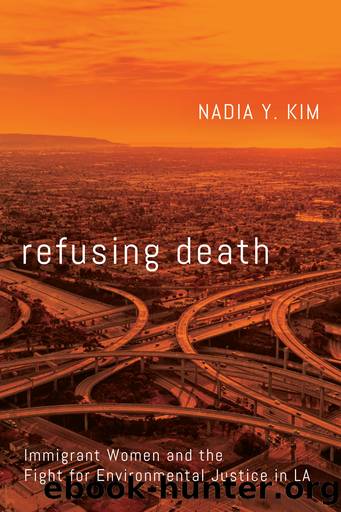Refusing Death by Nadia Y. Kim;

Author:Nadia Y. Kim;
Language: eng
Format: epub
Publisher: Stanford University Press
Published: 2021-06-15T00:00:00+00:00
I heard again and again about how regular people utilized the various assets already present in their neighborhoods to facilitate major episodes of collective actionâsometimes, even without professional social movement organizations or financial assistance from external actors, such as private foundations or national organizations.
As we saw in Chapter 2, not only did the immigrant women marshal everyday community resources to strategize emotions in their dealings with state and corporate officialsâalong the vertical axisâthey also intensely did so to movement-build on the ground, along the horizontal axis. Respected community leader Marta lives out this political philosophy, for instance, when she builds emotionality into her organizing activities: âFor me, personally, I like to do door knocking, to invite people to help with housing. I take some time to do that. I like to give phone calls to people to tell them that I missed them because they didnât come.â Much more than a phone tree reminder about this and that event, or about how industry will win if residents do not attend (which was how I used to organize), Marta makes it about how much she misses the residents in their absence. Similarly, Teresa never lived her day-to-day life without enacting the emotion work and emotional labor endemic to recruiting for the movement: âYeah, and if I see someone coughing, I say, âHey, are you feeling this way? I heard this might be because of pollution. Come to our meeting to get more information.â For example, at the laundromat, the women who are there, the individuals who are there, they just start talking, and thatâs just a topic that I bring up in order to talk about it [joining the movement].â
In addition to the types of grants their organizations received that tended to fund more innocuous activities, the Mexicana immigrantsâto a greater extent than the Asian Americans and more than any social movement I had ever engaged withâdevoted a large chunk of time to social activities, albeit those that were never unrelated to the movement (for example, Figure 12). CPC, for instance, offered myriad classes such as line dancing, danza Azteca, aerobics, cake-baking, flower-arranging, and, of course, healthier cooking classes. The health-related classes were to achieve the physical health that they were denied and the other classes were to forge the community and support structures for mental health that they were also denied. Recall, as well, the emphasis that Latina activists put on workshops and weeks-long seminars on dressing, doing hair, and wearing make-up professionally. These social âsisterlyâ events that I thought might take too much time, resources, and energy away from the good fight instead taught me that these allowed the women to politicize neighbors; grow the movement; buck elitesâ race, gender, and class stereotypes; develop their own self-worth and sense of superarse; and ultimately compensate for a life deprived of country and good health. Once I began attending more of these events, I understood much more intimately and deeply why they were so central to their lives and their politics.
Download
This site does not store any files on its server. We only index and link to content provided by other sites. Please contact the content providers to delete copyright contents if any and email us, we'll remove relevant links or contents immediately.
| Anthropology | Archaeology |
| Philosophy | Politics & Government |
| Social Sciences | Sociology |
| Women's Studies |
Nudge - Improving Decisions about Health, Wealth, and Happiness by Thaler Sunstein(7205)
iGen by Jean M. Twenge(5131)
The Fire Next Time by James Baldwin(4995)
Adulting by Kelly Williams Brown(4204)
The Hacking of the American Mind by Robert H. Lustig(4058)
The Sports Rules Book by Human Kinetics(4051)
The Ethical Slut by Janet W. Hardy(4013)
Captivate by Vanessa Van Edwards(3701)
Mummy Knew by Lisa James(3502)
In a Sunburned Country by Bill Bryson(3339)
The Worm at the Core by Sheldon Solomon(3301)
Ants Among Elephants by Sujatha Gidla(3267)
Suicide: A Study in Sociology by Emile Durkheim(2887)
The Slow Fix: Solve Problems, Work Smarter, and Live Better In a World Addicted to Speed by Carl Honore(2823)
The 48 laws of power by Robert Greene & Joost Elffers(2749)
Humans of New York by Brandon Stanton(2664)
Handbook of Forensic Sociology and Psychology by Stephen J. Morewitz & Mark L. Goldstein(2592)
The Happy Hooker by Xaviera Hollander(2565)
The Tipping Point by Malcolm Gladwell(2532)
